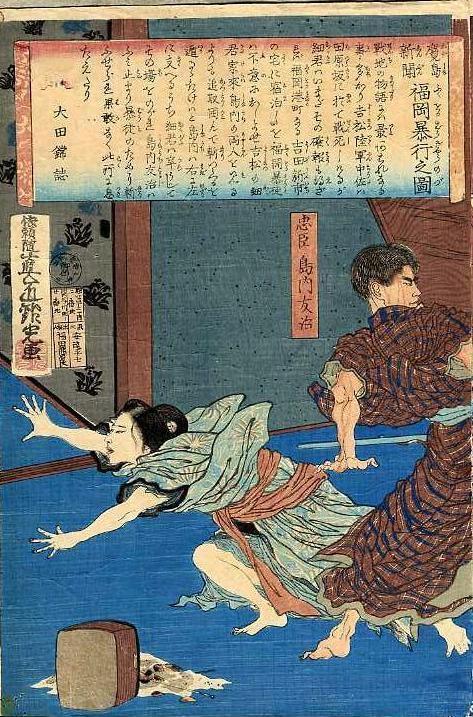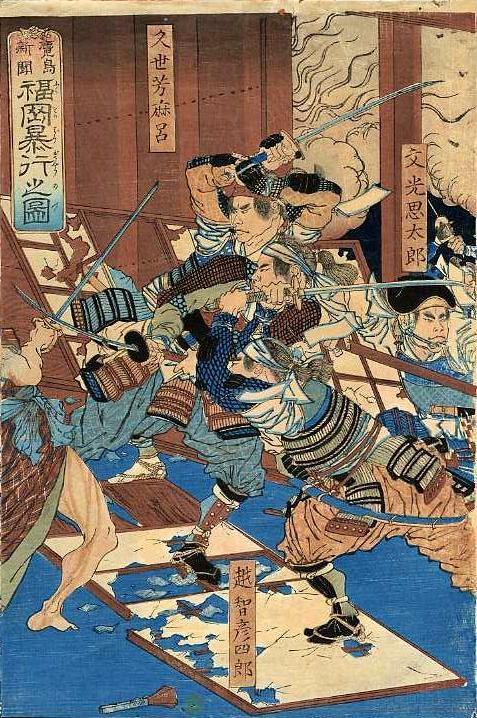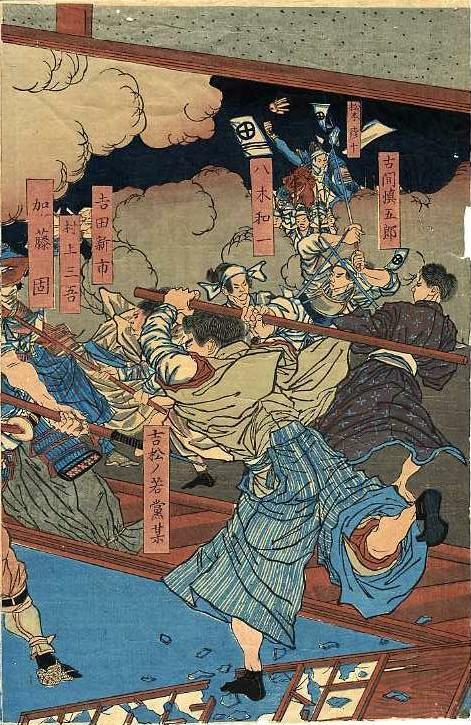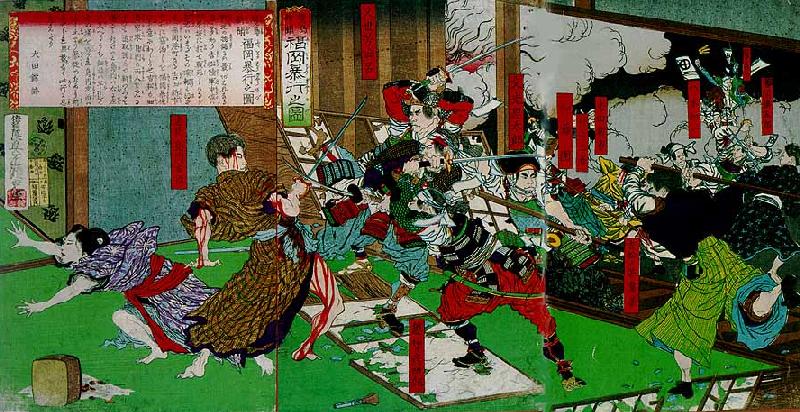Commentary
The name cartouche reads "loyal retainer Shimanouchi Tomoji". The other men in Yoshimatsu's service, and Yoshida himself, are out-armed and out-armored, if not also outnumbered. Presumably they also die, but the storyteller narrates only Shimanouchi's heroism as he plants his feet and -- blood streaming from his face, arms, and legs -- protects his lord's wife with his life.
Taharazaka
"Taharasaka" refers to Tabaruzaka (田原坂), in the vicinity of present-day Uekimachi, a town in Kumamoto prefecture. It was the site of the earliest and biggest battles of the Seinan War of 1877.
Fukuoka
The port town of Fukuoka is now the capital city of Fukuoka prefecture. The prefecture was the site of the Akizuki rebellion of 24 October 1876, the first of several related local revolts in Kyushu prefectures, and in Yamaguchi and a couple of other Honshu prefectures, that triggered the start of the Seinan War in late January and early February 1877.
Yoshimatsu Hideki
Yoshimatsu Hideki (吉松秀枝) died in the battle at Tabaruzaka holding off the the Satsuma army. He is called a "lieutenant colonel" (中佐 chūsa) in the story, but most historical sources refer to him as a "major" (少佐 shōsa) -- the same rank as his commander, Major Nogi Maresuke (乃木希典 1849-1912).
Yoshimatsu was the commander of the 3rd Regiment, which was the main unit of Nogi's 14th regiment. Nogi came to Yoshimatsu to inform him of the worsening situation. Yoshimatsu is supposed to have told Nogi that, as the regimental commander, he should not remain in the area, and gave Nogi his own horse so Nogi could return to his regimental headquarters.
In the battle that followed, Yoshimatsu died and Nogi lost his regimental banner -- which was to haunt him the rest of his life, as much as the loss of his two sons in the Russo-Japanese War, and the death of Emperor Meiji, which he took as a signal that he, too, should depart the world.
Yoshimatsu had been a military commander, known as Yoshimatsu Hayanosuke (吉松速之助), in the former Tosa domain in present-day Kochi prefecture on Shikoku. Nogi was from the Choshu domain, which centered on the town of Hagi in what became Yamaguchi prefecture. Most of the army's ranking officers were former Choshu samurai.
Usoura Government Army Cemetery
Yoshimatsu died in the Battle at Konoha on 23 February 1877. He is buried in the Usoura Government Army Cemetery (宇蘇浦官軍墓地) at Konoha in Gyokutōmachi, which neighbors Uekimachi. Some 398 officers and men of the government army, and police officers who fought with the government army as members of an ad hoc sabre regiment, are buried there.
Also buried at Usoura is Tanimura Keisuke (谷村計介 1853-1877), who died in a related Tabaruzaka battle on 4 March. Tanimura, born in Miyazaki, the son of a Kagoshima samurai, studied Yamaga-style military tactics from 1870, and became a soldier in the Kumamoto unit of the army in 1872.
Tanimura saw action during the Saga rebellion of 1874 and the Shinpuren rebellion of 1876. He was at Kumamoto castle when it was surrounded by Saigo's Satsuma army in early 1877, but escaped and joined the government forces. (Source on life of Tanimura: National Diet Library. NDL's Portraits of Modern Japanese Historical Figures (近代日本人の肖像) feature has a photograph of the young man, who had turned 24 only three weeks before his death.)
Striking color changes
The copy of the triptych in Yosha Bunko appears to have been printed with a totally different set of pigments than the copy in the Meiji Shinbun Zasshi Bunko at the University of Tokyo.
All the reds in the University of Tokyo print appear as a washed-out rusty pink in the Yosha Bunko copy. All the greens have become blues. Some purples have become different blues. And most of the other colors have subtly changed.
Frankly, I find the subdued colors of the Yosha Bunko print more interesting. But they are the result of long exposure to light and probably moisture and dirty air.
How do I know this?
Because each corner of the Yosha Bunko triptych has traces of a round tack. And the circular spots -- one in the lower left corner of the left sheet, another in the middle of the bottom of the middle sheet -- are bright green like the University of Tokyo copy.
Not all differences can be accounted for by color changes, however. There is no green along the bottom of the story cartouche on the University of Tokyo print, corresponding to the blue on the Yosha Bunko print -- among other evidence that the copies are from a different run.
Print information
Series: Kagoshima shinbun
Title: Fukuoka boko no zu
Notification date: 1877-5
Drawer: Adachi Heishichi
Signed: (Irai shitagai) Shinsho Ginko [Adachi Ginko]
Writer: Oota [Kanetsune] [Tenative 大田 (金+常)]
Carver: Unsigned
Publisher: Fukuda Kumajiro [Gusokuya]
Size: Oban triptych
Images: Tokyo University (Kinoshita and Yoshimi 1999), Yosha Bunko
Principal sources
Yosha Bunko
Kinoshita and Yoshimi 1999 (Nyuusu no Tanjo)



